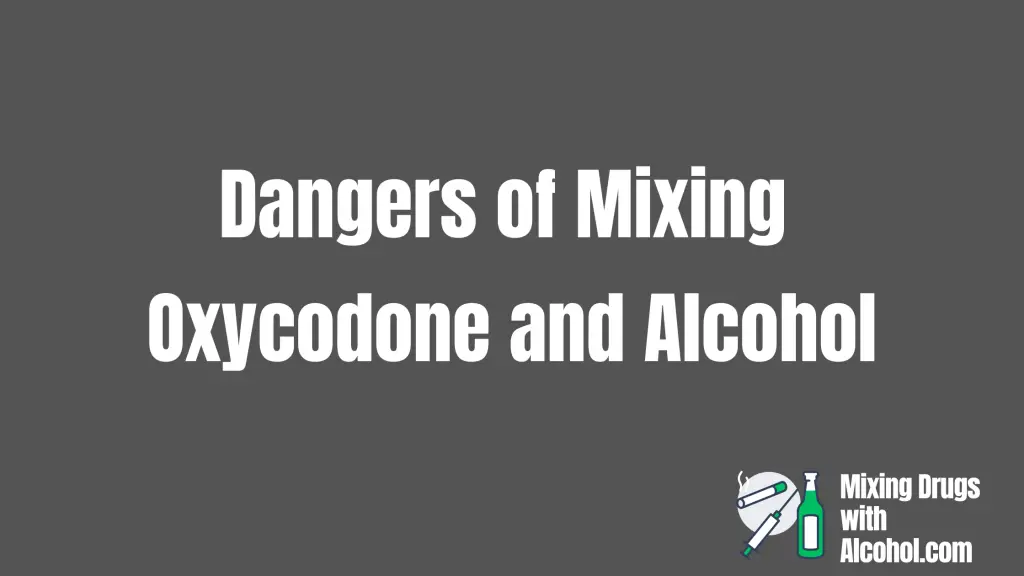Mixing oxycodone with alcohol can lead to serious health risks, including overdose and death. Oxycodone is a type of opioid used to relieve pain, but it carries a high risk of addiction and abuse. Alcohol is a depressant that affects the central nervous system and can impair judgment and motor coordination.
When combined, the risk of overdose and slowed breathing leading to coma or death increases. Alternative treatments for pain management should be considered to avoid these potential dangers.
How Long After Taking Oxycodone Can You Drink?
Mixing oxycodone and alcohol can be dangerous and even life-threatening. Oxycodone is an opioid medication prescribed for pain relief that affects brain chemistry by reducing pain perception. It can cause side effects like dizziness, constipation, and confusion. When combined with alcohol, the effects can become more pronounced and potent due to synergistic interactions between them.
It is recommended to wait at least four hours after taking oxycodone before consuming any amount of alcohol. However, it’s best to avoid mixing these substances altogether, as it can increase the risk of respiratory depression, overdose, and death.
What Is Oxycodone?
Oxycodone is an opioid medication that reduces pain by changing the way the brain and nervous system respond to it. It can be taken orally or via injection for moderate-to-severe short-term pain.
However, when abused or combined with alcohol, it can lead to serious side effects like slowed breathing, confusion, and coma. Prolonged use may result in tolerance and addiction. It’s essential to avoid alcohol or wait at least four hours after taking oxycodone before drinking. Combining the two increases the risk of respiratory depression, overdose, and death.
Is It Safe To Take Oxycodone With Alcohol?
Mixing oxycodone and alcohol is not recommended due to the potential for severe side effects, including respiratory depression, overdose, and even death. It’s important to avoid alcohol altogether when taking oxycodone, as there is no safe amount.
Additionally, tolerance can develop over time, increasing the risk of addiction and abuse. It’s crucial to discuss all risks with a doctor before combining oxycodone with other drugs or alcohol.
Side-Effects Of Taking Oxycodone And Alcohol
Mixing oxycodone and alcohol can have serious side effects, both in the short and long-term. Here are some of the potential side effects:
Short-term side effects:
- Increased risk of respiratory depression and respiratory failure
- Increased risk of dizziness and sedation
- Increased risk of nausea and vomiting
- Increased risk of impaired coordination and judgment
- Increased risk of accidents and injuries
- Increased risk of overdose, which can lead to coma and death
Long-term side effects:
- Increased risk of addiction and dependence on both oxycodone and alcohol
- Increased risk of liver damage and liver disease
- Increased risk of brain damage and cognitive impairment
- Increased risk of gastrointestinal problems, including ulcers and bleeding
- Increased risk of heart problems, including heart attack and stroke
- Increased risk of mental health problems, including depression and anxiety
It’s important to note that these are just some of the potential side effects of mixing oxycodone and alcohol, and the specific side effects may vary depending on a person’s individual health history and the dosage of the drugs they are taking. It’s also important to seek medical attention immediately if you or someone you know experiences any of these side effects, as they can be life-threatening.
How To Take Medication Safely
Safety should always be a top priority when taking medication, especially when it comes to mixing substances like oxycodone and alcohol. To ensure safe use of prescription and over-the-counter drugs, speak to a doctor about potential interactions.
Other steps to safely manage medication include reading the label, keeping a list, informing medical professionals of all current medications, never sharing prescriptions, disposing of expired drugs properly, and consulting with a healthcare provider immediately if experiencing side effects. Following these guidelines can reduce the risk of harmful outcomes from medication use.
Taking Oxycodone And Other Drugs
Combining medication and drugs can have serious consequences. Mixing opioids like oxycodone with alcohol increases the risk of side effects and can lead to extreme sedation or even coma. It is important to speak to your doctor before using any medication to understand the potential risks and benefits. Your doctor can provide personalized advice on how to safely use prescribed medications, including oxycodone, to reduce harm and prevent negative interactions.
Oxycodone And Caffeine Interaction
Mixing oxycodone with other substances can be risky. Caffeine, for example, can cause interactions with oxycodone and increase the likelihood of side effects such as nausea, vomiting, restlessness, anxiety, headaches, increased heart rate, and difficulty sleeping.
To minimize these risks, it’s recommended to limit caffeine intake to 400 mg per day while using oxycodone. If you experience any adverse reactions, speak with your doctor to discuss alternative medications or reducing caffeine intake.
Frequently Asked Questions About Dangers Of Mixing Oxycodone And Alcohol:
What medication can you not drink alcohol with?
Alcohol should not be consumed with medications that can cause drowsiness, including pain relievers like oxycodone. This combination can lead to increased sedation and respiratory depression, which can be life-threatening.
What should you not mix oxycodone with?
Oxycodone should not be mixed with alcohol or other drugs that can cause respiratory depression or sedation. Mixing these substances can increase the risk of overdose and other serious side effects.
Can you take pain medicine with alcohol?
It is not recommended to take pain medicine like oxycodone with alcohol. Both substances can cause drowsiness and impair judgment and coordination, which can increase the risk of accidents and injuries.
How long should I wait to take painkillers after drinking alcohol?
The dosage of oxycodone depends on various factors, including the severity of pain, age, weight, and overall health. It is important to follow the prescribed dosage and consult a healthcare provider if there are concerns about the medication’s effects or potential interactions. Taking multiple doses of oxycodone can increase the risk of overdose and other serious health complications.
- Substance Abuse and Mental Health Services Administration (SAMHSA). (2018). The Dangers of Mixing Alcohol and Drugs. Retrieved from https://www.samhsa.gov/sites/default/files/programs_campaigns/awareness_day/2018/2018MixingAlcoholAndDrugs.pdf
- National Institute on Drug Abuse (NIDA). (2021). Prescription Opioids DrugFacts. Retrieved from https://www.drugabuse.gov/publications/drugfacts/prescription-opioids
- American Society of Addiction Medicine (ASAM). (2015). Opioid Addiction Treatment: A Guide for Patients, Families, and Friends. Retrieved from https://www.asam.org/docs/default-source/patient-resources/opioid-addiction-treatment-a-guide-for-patients-families-and-friends.pdf
- Centers for Disease Control and Prevention (CDC). (2021). Opioid Overdose. Retrieved from https://www.cdc.gov/drugoverdose/opioids/index.html
- U.S. Food and Drug Administration (FDA). (2021). Oxycodone Information. Retrieved from https://www.fda.gov/drugs/drug-safety-and-availability/oxycodone-information
Similar Articles
Prednisone And Alcohol
Amoxicillin and Alcohol
Lexapro and Alcohol
Doxycycline Hyclate and Alcohol
Zoloft and Alcohol
Ibuprofen and Alcohol
Methylprednisolone and Alcohol
Antidepressants and Alcohol
Muscle Relaxers and Alcohol
Nitrofurantoin and Alcohol
Blood Thinners and Alcohol
Pfizer vaccine and Alcohol
Valacyclovir and Alcohol
Indomethacin and Alcohol
Ashwagandha and Alcohol
Mirtazapine and Alcohol

